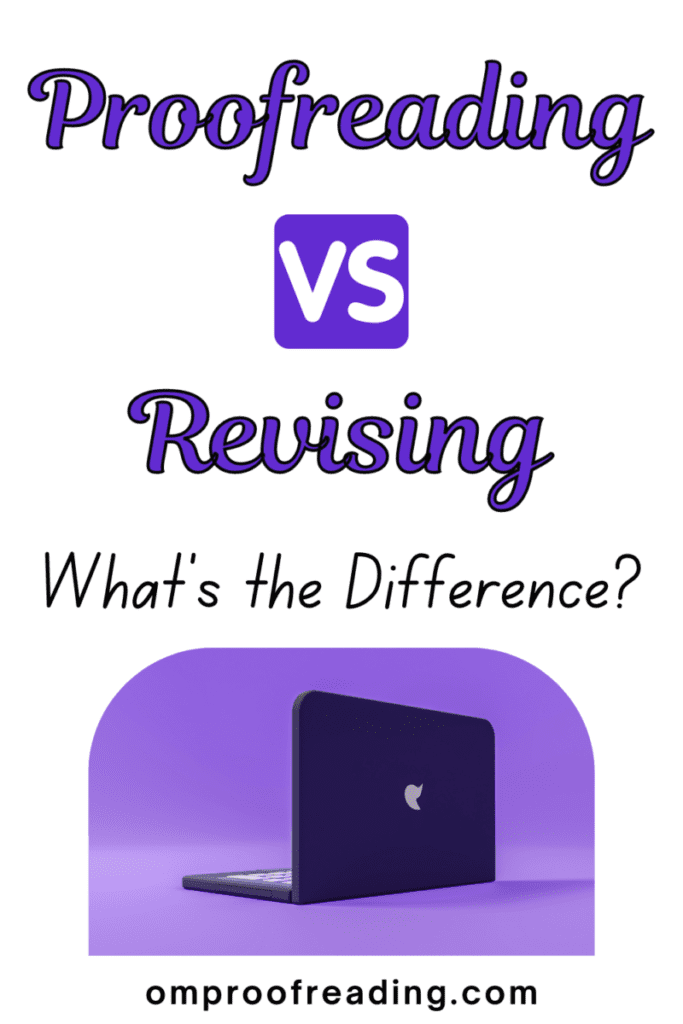This article may contain affiliate links. Please see our affiliate disclaimer in the footer menu for more information. Thank you for your support!

Although we sometimes use the terms proofreading and revising interchangeably, they’re distinct stages in the writing process. Both phases entail making improvements to writing, but their scope varies considerably.
Revision involves improving the content and organization of writing to enhance its effectiveness and influence, thereby making it fit for purpose. Proofreading is the process of fixing grammar, capitalization, punctuation, spelling, and formatting errors in the final draft of a document.
Let’s discover the differences between proofreading and revising, where they fit into the writing process, and tips for successfully executing these steps.
Proofreading vs. Revising: How Are They Different?
Before we go into detail, here’s a chart summarizing the key differences between revising and proofreading.
Proofreading vs. Revising
| Proofreading | Revising | |
|---|---|---|
| What? | eliminate mechanical errors (grammar, punctuation, etc.) | make content and organization more effective and impactful |
| Why? | to make sure writing looks polished and professional | to ensure writing achieves its objective and suits the target audience |
| When? | after revising and editing stages | after or during writing the first draft |
| How Long? | relatively fast procedure | takes some time |
What Is Proofreading?
Proofreading is the process of reviewing a text with a fine-tooth comb to find and fix surface-level errors.
Proofing involves eliminating mistakes in five main areas:
- grammar
- capitalization
- punctuation
- spelling
- formatting
It also entails checking for proper word use, paying attention to missing or repeated words, and ensuring writing follows the appropriate style guide (e.g., The Chicago Manual of Style).
Later, we’ll see precisely what to keep an eye out for when you proof your prose.
What Is Revising?
The idea of revising is in the word revision. We know re means again, and vision has to do with seeing.
Revision is simply seeing your writing again with a critical eye to make it better.
Revising deals with the big picture, focusing on structure and content.
Neil Gaiman, a renowned British author, defines revision and offers guidance on the process:
“The best advice I can give on this is, once it’s done, to put it away until you can read it with new eyes. When you’re ready, pick it up and read it as if you’ve never read it before. If there are things you aren’t satisfied with as a reader, go in and fix them as a writer: that’s revision.”
– Neil Gaiman (taken from Goodreads)
In a bit, we’ll explore the specific elements to look at when revising.
First, let’s uncover the purpose of proofreading and revising.
The Purpose of Proofreading vs. Revising

The primary purpose of proofreading is to make the final draft as polished as possible.
Proofreading ensures the author is seen as a credible source and that readers can focus on the writer’s words instead of getting distracted by overlooked mistakes.
Writing that hasn’t been proofread can look sloppy and cause misunderstandings.
I penned a post about why proofreading is crucial if you’d like to learn more.
The primary purpose of revision is to ensure a document is fit for purpose.
A text is fit for purpose when it meets its intended objective (e.g., to educate, persuade, entertain) and communicates information clearly and effectively to the target audience.
For example, I determined this blog post was (hopefully 😉) fit for purpose when I felt it clearly and thoroughly explained the difference between proofreading and revising.
What Comes First: Proofreading or Revising?
Revising comes before proofreading.
Revising deals with making substantial modifications to a document, like adding, deleting, and reorganizing large portions of text.
Proofreading is the last step in the writing process.
Proofreading before revising wouldn’t make sense because revision may entail deleting text you’ve already proofed or adding sections that require proofing.
Some folks revise their writing during the drafting stage, while others prefer to wait to revise until after they finish the first draft.
People who continuously revise while writing won’t have as much work left after finishing the first draft.
However, some writers don’t like revising as they go because they feel it interrupts the flow of drafting.
You can revise whenever it works best for you.
“The beautiful part of writing is that you don’t have to get it right the first time, unlike, say, a brain surgeon.”
– Robert Cormier (taken from Goodreads)
How Long Do Proofreading and Revising Take?

Proofreading and revising are both iterative procedures; they involve repetition. However, revising takes much longer than proofreading.
That being said, proofreading takes longer than most people think because it needs to be done slowly to be effective.
Proofreading occurs after revising and editing, though, so the writing should already be in reasonably good shape. Proofing aims to catch errors that were missed or introduced during previous editing stages.
It’s the step that comes right before sharing the text with readers in some way—publishing a blog post, handing in a paper to a professor, etc.
I authored an article about how long proofreading takes if you’re interested.
Revising is a lengthier process since it takes place during or after writing the first draft, when the text is still in fairly rough shape.
And although revision focuses on making significant alterations to a text, most writers make some minor changes (e.g., nixing obvious grammar or word usage errors) during the revision process.
What to Look for When Proofreading a Document
You’ll want to focus on the following when proofreading:
Grammar
- Avoiding sentence fragments in formal writing
- Using the correct verb tense
- Checking for subject/verb agreement and pronoun/antecedent agreement
- Choosing the proper pronouns, prepositions, and conjunctions
- Eliminating mix-ups with adverbs and adjectives
Capitalization
- Checking that proper nouns are capitalized (but not common nouns)
- Making sure the pronoun I is capitalized
- Ensuring words are capitalized elsewhere as needed (e.g., the first word in a sentence)
Punctuation
- Correctly using punctuation marks when needed
Spelling
- Paying close attention to mistakes with homophones (e.g., waist vs. waste)
- Ensuring names of people, places, businesses, etc., aren’t misspelled
Formatting
- Using the right font size and style
- Making sure spacing is correct and consistent throughout
- Checking that citations and references are properly formatted (if needed)
Proofreading also includes these tasks:
- Checking for missing or repeated words
- Eliminating word usage errors
- Ensuring writing follows the appropriate style guide
What to Look for When Revising a Document

When revising your document, you want to keep your target audience in mind.
Keeping your readers in mind will help you fulfill the objective of your writing.
Is your writing meant to be informative, persuasive, humorous?
The primary purpose of this blog post is to be helpful and informative—and, hopefully, entertaining. 😊 I see I haven’t lost you yet. 😉
Here’s what you’ll want to focus on during revision:
Content
- Adding information or explanations to fill in gaps in communication
- Deleting superfluous information (any fluff or off-topic ideas)
- Communicating ideas clearly and using language the audience will understand
- Including all points and sufficient examples to illustrate them
- Covering all arguments and providing enough evidence to support them (e.g., in a thesis)
Organization
- Having an engaging introduction that lets the reader know what will be covered
- Providing a conclusion that adequately recaps the main points
- Reorganizing paragraphs or sentences to ensure a logical and cohesive structure
- Giving enough context in previous paragraphs so audience can understand later paragraphs
- Using appropriate transitions between paragraphs and sentences to ensure writing flows well
If you have a book manuscript or screenplay, revising will look a bit different.
You’ll focus on elements like the plot, characters, setting, and dialogue as you review your writing and make improvements.
Where Proofreading and Revising Fit Into the Writing Process
Proofreading and revising are crucial parts of the writing process, so let’s see where they fit in.
The Writing Process
The writing process is the series of steps a writer takes to compose a document—from planning it to publishing it.
It’s not linear; writers often return to previous steps when needed.
This procedure looks different from one person to the next and even varies for the same person depending on the writing assignment.
Let’s divide the writing process into six steps.
1) Prewriting
Prewriting means planning what you’ll write about—coming up with the topic, generating ideas, and organizing them.
Specifically, it can include activities like jotting down notes, brainstorming, and outlining.
2) Research
Researching, if needed, entails consulting other sources to learn more about the subject you plan to write about.
Once you have sufficient knowledge about your topic, it’s time to start drafting.
3) Drafting
Drafting is when your fingers start tapping the keys on your keyboard.

Or if you’re me, it’s when you start dipping your feather into black ink.
Okay, maybe not. 😉 But I used to draft my blog posts with pen and paper before typing them up. I’m old-fashioned.
I now draft articles on my computer since it’s more time efficient, but I still enjoy outlining articles on paper occasionally.
4) Revising
We know all about revision now.
Revision means reviewing and improving your writing with a focus on big-picture elements.
5) Editing
Like revising, editing encompasses improvements to content and structure. It also considers the language used with respect to flow, clarity, and consistency in style and tone.
Finally, it deals with making the writing more concise and consistent in terms of grammar, punctuation, and spelling.
We’ll look at different editing stages soon when we compare revising to editing.
6) Proofreading
As we know, proofreading means fixing remaining errors and making the text as reader-ready as possible.
Tips to Effectively Revise and Proofread Your Writing

Many of the same tips for revising your writing also apply to proofreading (and editing).
1) Have your word processor read your writing.
Let Word or Google Docs read your writing aloud.
Listening to our words gives our eyes a break.
Listening to our writing while revising lets us hear when the organization is wonky or when we stray off-topic.
During proofreading, hearing our writing is an ideal way to identify repeated or omitted words because our eyes can’t skim over repetitions or let our brain fill in words that aren’t there.
2) Go through it more than once.
Even though I’m a trained proofreader, I’m still surprised by how many errors I miss on the first pass when proofing my writing.
Reading your text at least twice is helpful.
3) Ask for help.
Consider having a revision partner if it’s feasible. Otherwise, having a family member or friend critique your writing can be helpful.
And if you have an important document, you may want to consider hiring a proofreader.
4) Know your typical errors.
The Find function is fantastic for identifying those mistakes you can’t seem to stop making.
If you often misuse colons, type a colon into the Find search box to find all the colons in your writing to ensure you don’t have any colon calamities. 😊
5) Use all your resources.
Not sure about the exact meaning or connotation of a word? Happens to me often.
If I had to reach Merriam-Webster’s Collegiate Dictionary by phone, I’d have it on speed dial.
The thesaurus would be there too: we all have words we tend to overuse and need alternatives for.
And although spellcheckers and grammar checkers have limitations, they’re still helpful.
If you need grammar guidance, check out my article about how to improve your grammar skills.
6) Get some distance.
Taking a step back before revising and before proofreading lets you approach the document more objectively.
Pretending the writing belongs to someone else can help you to adopt a more critical eye during the revision process.
Humility is important during revision.
I know my first draft isn’t going to be very effective if I don’t spend time reworking it. I’d like to think I can crank out a decent document on the first try.
I cannot.
Instead, I need to spend substantial time whipping my writing into shape. Hopefully, it’s a shape people enjoy reading. 😉
Revising vs. Editing

When discussing how revising and editing differ, it’s crucial to distinguish between the kinds of editing:
- developmental editing
- line editing
- copyediting
These types of editing make up the first three steps in the traditional four-stage editorial process.
Can you guess the last step? If you think it’s proofreading, you’re right!
Developmental editing and revision are quite similar since both involve making changes to the writing as a whole—mainly to the content and organization.
However, these steps aren’t identical:
“Revision involves many of the strategies known generally as editing but also can entail larger conceptual shifts of purpose and audience as well as content.”
– Wikipedia
Furthermore, the document’s author typically revises their writing. But editing can be done by the writer or a professional.
Line editing enhances the language in a document, improving its style, tone, and readability.
Copyediting means making the writing clear and concise. It also ensures a document is correct and consistent concerning grammar and mechanics.
Proofreading vs. Editing
When people consider proofreading vs. editing, they usually think of how proofreading compares to developmental editing (not line editing or copyediting).
As mentioned, the editorial process begins with developmental editing and ends with proofreading.
So timing is one difference.
The other primary difference is that editing deals with the document as a whole (enhancing the content and organization), whereas proofreading looks at the details (grammar and mechanics).
Frequently Asked Questions
What’s the difference between proofreading and rewriting?
Proofreading is checking the final draft to fix errors missed in previous editing stages. Rewriting is an extensive procedure that involves reconstructing a document. It may include altering the point of view or changing the text to better match its purpose or intended audience.
What’s the difference between revising and drafting?
Drafting involves writing words to compose a document. Revising consists of making substantial changes to the draft by enhancing its content and structure, ensuring it serves its purpose and suits the intended audience.
I hope this post has helped you understand the difference between proofreading and revising and where they fit into the writing process.
Best wishes to you!
“When one tugs at a single thing in nature, he finds it attached to the rest of the world.”
– John Muir

Recent Posts
Punctuation is important because it enables us to communicate our message clearly and effectively. Without punctuation, we wouldn’t understand how units of a sentence relate to one another or how...
Although you're probably somewhat familiar with adverbs, you may be unaware of sentence adverbs. As a trained proofreader who has studied the parts of speech, I can help you understand this unique...
